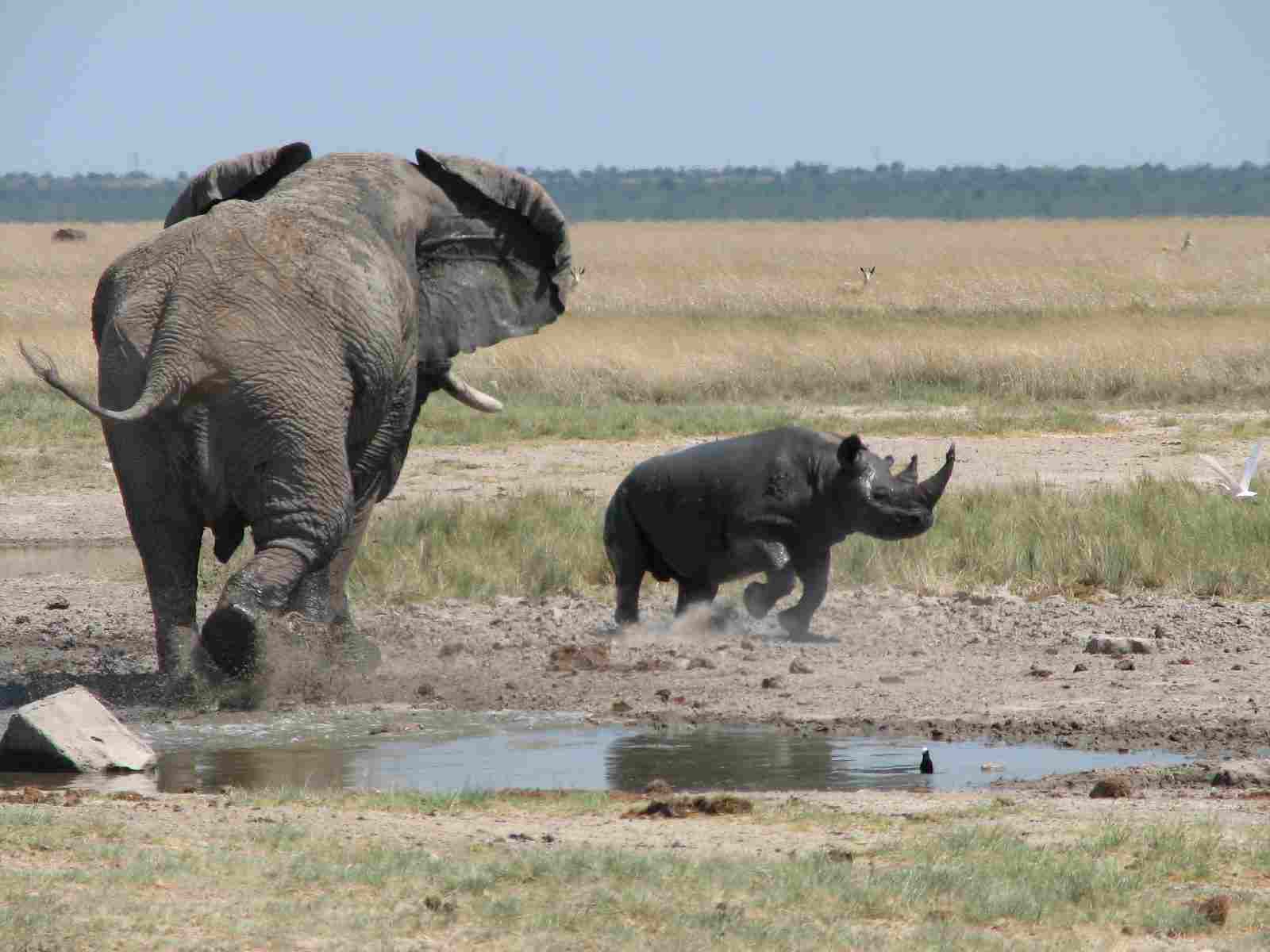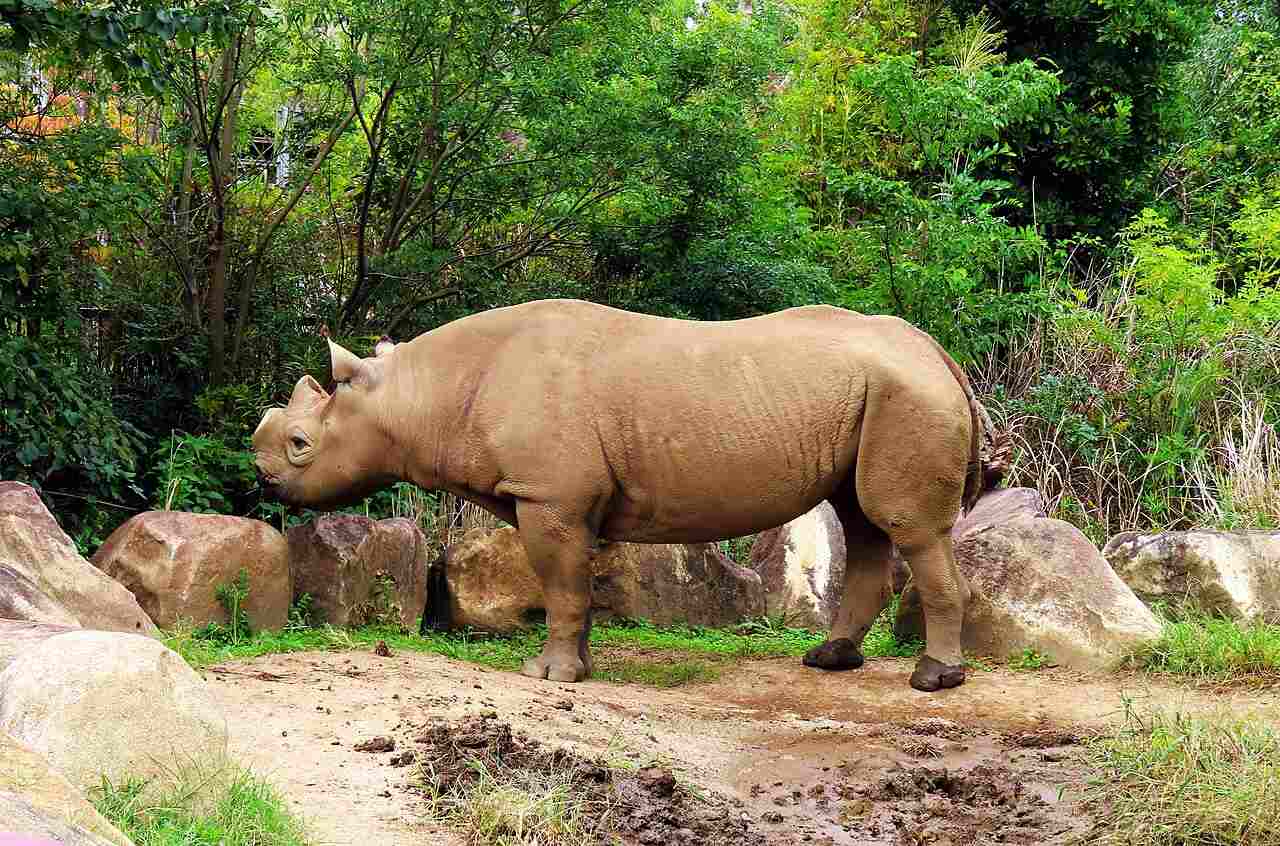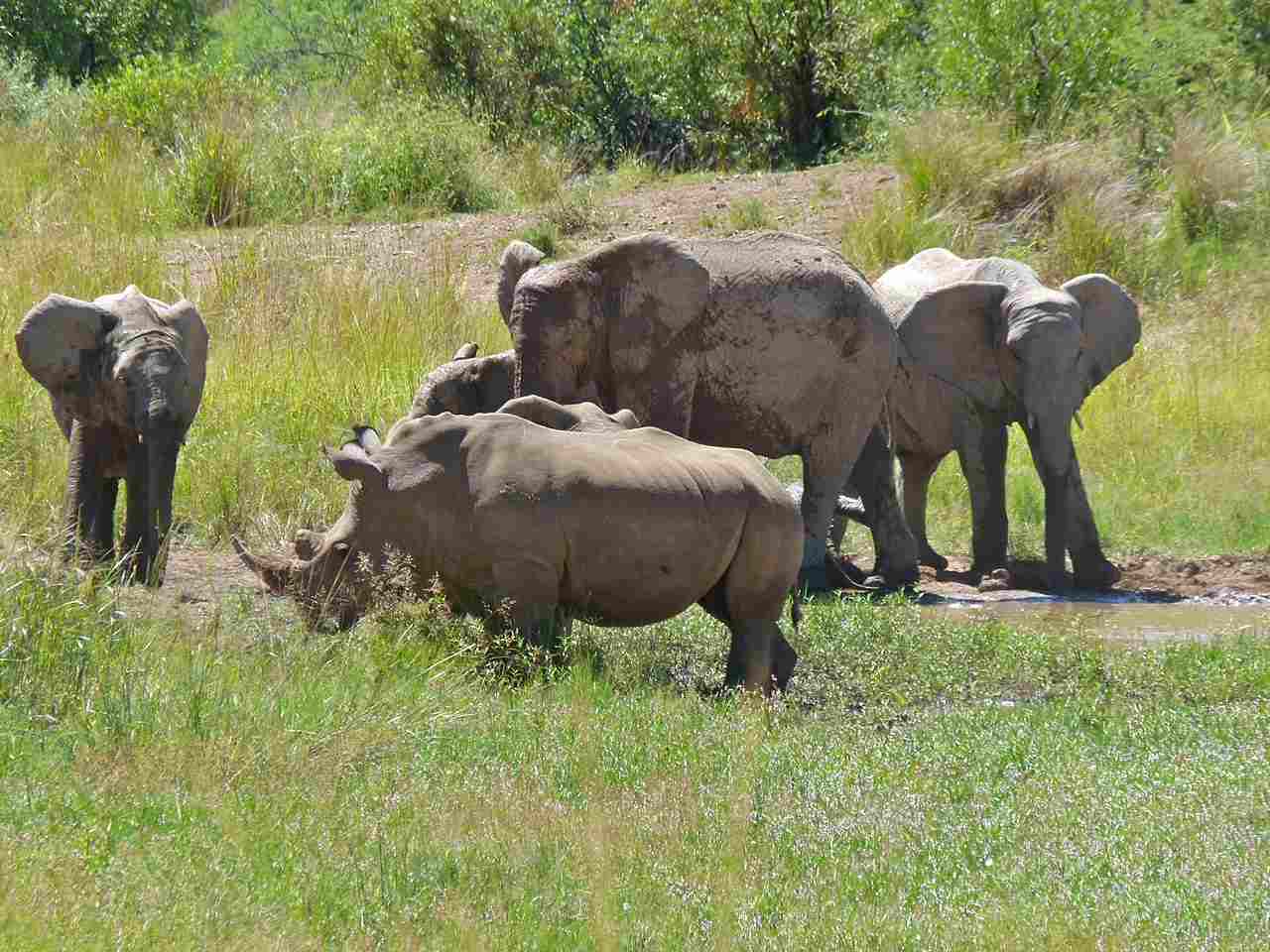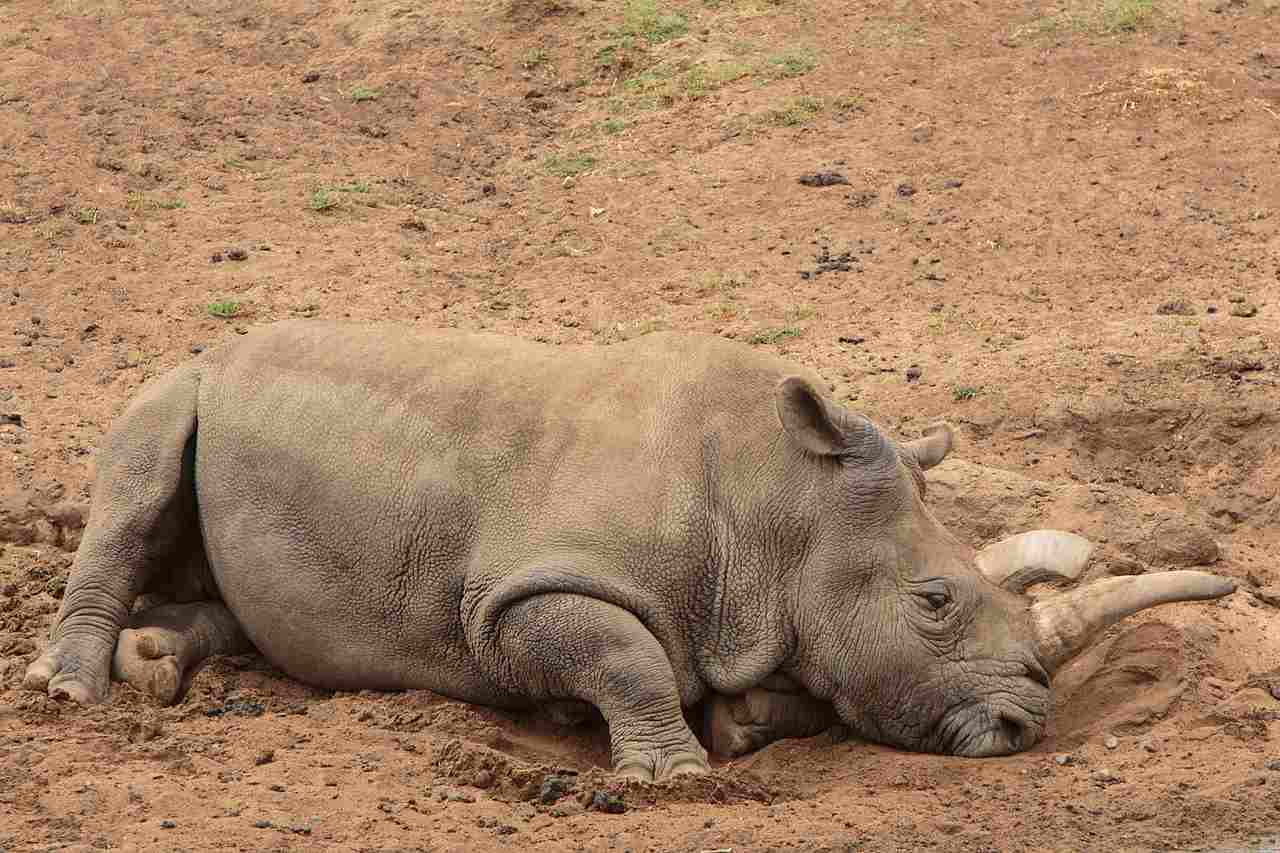Rhino Vs Elephant Size, Weight, Ecological Comparison
An elephant will overpower and potentially kill a rhino in a confrontation, due to its immense advantage in size, weight and strength.
Various factors can be used to compare rhinos and elephants. Taxonomy, appearance, size, weight, bite force, overall physical capacity, habitat, lifespan, behavior, reproduction, danger posed to humans, and conservation status are all important aspects to consider.
Key Outcomes
*Biological Comparison
Rhinos and elephants may seem similar in appearance, but are they biologically related? Let’s explore the biological comparison between these magnificent creatures.
While both rhinos and elephants belong to the animal kingdom, they are not closely related in terms of genus and species. Rhinos are part of the family Rhinocerotidae, while elephants belong to the family Elephantidae. This means that they have distinct evolutionary lineages and genetic differences.
Despite their biological differences, there are still interesting comparisons to be made between these animals. Both rhinos and elephants are large herbivores, and play crucial roles in their respective ecosystems, modifying the landscape and influencing plant diversity.
*Size and Weight Comparison
Rhinos and elephants are both known for their impressive size and weight. When it comes to size, elephants are larger than rhinos. An adult male African elephant can reach a height of up to 13 feet at the shoulder and weigh between 5,000 to 14,000 pounds. In comparison, adult male rhinos stand at around 5 to 6 feet tall at the shoulder and weigh between 2,000 to 7,000 pounds.
The weight of these animals is influenced by various factors such as species, age, and gender. African elephants are generally larger and heavier than their Asian counterparts. Both rhinos and elephants have robust bodies, but elephants have a more massive build overall.
*Physical Capability Comparison
The physical capabilities of elephants and rhinos differ significantly. Elephants are known for their immense strength, which surpasses that of rhinos. In a direct confrontation, the elephant’s strength would likely overpower the rhino, potentially leading to its demise.
1). Taxonomy
The taxonomy of elephants and rhinos reveals interesting similarities and differences between the two species. Both elephants and rhinos belong to the animal kingdom, phylum Chordata, and class Mammalia. However, they diverge at the order level, with elephants classified under the order Proboscidea and rhinos under the order Perissodactyla.
Within the order Proboscidea, elephants are further classified into three species: the African bush elephant (Loxodonta africana), the African forest elephant (Loxodonta cyclotis), and the Asian elephant (Elephas maximus). On the other hand, rhinos are divided into five species: the white rhinoceros (Ceratotherium simum), the black rhinoceros (Diceros bicornis), the Indian rhinoceros (Rhinoceros unicornis), the Javan rhinoceros (Rhinoceros sondaicus), and the Sumatran rhinoceros (Dicerorhinus sumatrensis).
2). Appearance
The appearance of elephants and rhinos is distinct and unique to each species. Starting with their coats, elephants have a sparse covering of hair on their bodies, while rhinos have thick, armor-like skin. This difference in fur and skin is not only for aesthetic purposes but also serves functional roles.
Elephants’ sparse hair allows them to regulate their body temperature more efficiently, as it prevents heat from getting trapped. On the other hand, rhinos’ thick skin acts as a form of protection against predators and environmental hazards.
In terms of camouflage, elephants have a grayish-brown coloration that helps them blend into their natural habitat, such as savannahs and forests. Rhinos, on the other hand, have a gray or brownish-gray color that helps them blend into their surroundings, particularly in grasslands and shrublands.
When it comes to stature and build, elephants are known for their large size and distinctive shape, with a long trunk and prominent tusks. Rhinos, on the other hand, have a more compact and robust build, with a horn on their snout.
3). Size
When comparing the size of elephants and rhinos, we need to consider their total body length and height at the shoulders. Elephants are known for their impressive size, with the African elephant being the largest land animal on Earth.
They can reach lengths of up to 24 feet and stand at a shoulder height of around 10 to 13 feet. On the other hand, rhinos are also sizable creatures, but they are smaller than elephants. The white rhinoceros, for example, can grow up to 13 to 16 feet in length and stand at a shoulder height of about 5 to 6 feet.
The difference in size between elephants and rhinos is significant, with elephants being much larger overall. This size advantage gives elephants a greater presence and dominance in their habitats. It also contributes to their ability to forage for food over larger areas and navigate through different types of terrain. Rhinos, although smaller, are still formidable creatures with their own unique adaptations and physical capabilities.
4). Weight
When comparing the weight of elephants and rhinos, it is clear that elephants are significantly heavier than rhinos. Elephants are known for their massive size, and this is reflected in their weight. The African elephant, for instance, can weigh anywhere between 5,000 to 14,000 kilograms (11,000 to 31,000 pounds). On the other hand, rhinos are also hefty creatures, but they are comparatively lighter. The white rhinoceros, for example, typically weighs around 2,300 to 3,600 kilograms (5,000 to 8,000 pounds).
The difference in weight between elephants and rhinos is substantial, with elephants outweighing rhinos by a significant margin. This weight advantage gives elephants a greater presence and power in their ecosystems. It allows them to exert dominance and navigate through their habitats with relative ease. Rhinos, although not as heavy, still possess considerable strength and agility, which they utilize for various activities such as foraging and defending themselves.

5). Bite Force
The bite force of an animal is a crucial factor in determining its predatory or defensive capabilities. When comparing the bite force of elephants and rhinos, it is evident that both animals possess formidable strength in their jaws.
Elephants, with their massive size and powerful tusks, have a bite force of over 2,000 psi, which far exceeds that of rhinos at around 1,500 psi. Their tusks, which are elongated incisor teeth, can exert a tremendous amount of pressure. This allows elephants to break through tough vegetation, strip bark from trees, and even defend themselves against predators.
On the other hand, rhinos also have a strong bite force, although not as powerful as elephants. Rhinos use their sharp incisor teeth and powerful jaws to graze on grasses and browse on leaves. Their bite force enables them to tear through vegetation efficiently and extract the nutrients they need.
While elephants have a greater overall bite force due to their larger size and tusks, rhinos still possess a formidable bite force that serves them well in their herbivorous diet.
6). Overall Physical Capacity
In terms of strength, elephants have the advantage over rhinos due to their sheer size and robust build. They are known for their ability to uproot trees, push heavy objects, and even overturn vehicles. This immense strength is a result of their robust skeletal structure and powerful muscles, allowing them to exert tremendous force when needed.
Rhinos, on the other hand, may not match the raw strength of elephants, but they possess their own set of physical capabilities. Their compact and muscular bodies enable them to charge at high speeds, reaching up to 30 miles per hour. This agility, combined with their sharp horns, makes them formidable opponents when defending themselves or their territory.
In terms of a violent confrontation between the two, the elephant is likely to win due to its size and weight advantages. However, the outcome can vary significantly with several factors. Both elephants and rhinos have the potential to cause significant harm to each other. However, it is important to note that such confrontations are rare in the wild, as these animals typically avoid direct conflicts and resort to displays of dominance instead.
7). Habitat
Rhinos are primarily found in grasslands, savannas, and dense forests across Africa and Asia. They have adapted to a variety of ecosystems, including wetlands, swamps, and even deserts. Rhinos are known to be selective feeders, preferring areas with abundant vegetation and access to water sources. Their habitat requirements are closely tied to the availability of suitable food and water, as well as the presence of suitable shelter and breeding grounds.
Elephants, on the other hand, inhabit a wide range of habitats, including grasslands, forests, and even mountainous regions. They are highly adaptable and can be found in diverse environments, from dense rainforests to arid deserts. Elephants are known to have a significant impact on their habitat, shaping the landscape through their feeding and movement patterns. They play a crucial role in maintaining the balance of ecosystems by dispersing seeds, creating water holes, and clearing vegetation.
While both rhinos and elephants have overlapping geographic ranges in certain areas, their specific habitat preferences and ecological roles differ. Rhinos are more specialized in their habitat requirements, while elephants are more versatile and can thrive in a wider range of environments.
8). Lifespan
When comparing the lifespan of rhinos and elephants, it is important to consider the differences between these two magnificent creatures. Rhinos have an average lifespan of around 40 to 50 years in the wild, although some species, like the white rhino, can live up to 50 to 60 years. On the other hand, elephants have a longer lifespan, with an average of 60 to 70 years in the wild. Some elephants have been known to live well into their 70s and even 80s.
The lifespan of both rhinos and elephants can be influenced by various factors, including habitat quality, availability of food and water, predation, and human activities such as poaching and habitat destruction. Rhinos, in particular, face significant threats from poaching for their horns, which has led to a decline in their population and a decrease in their average lifespan.
Elephants, on the other hand, are also facing challenges due to habitat loss and poaching for their ivory tusks. However, their longer lifespan can be attributed to their social structure and the protection provided by their herds. Elephants live in close-knit family groups, with older individuals passing down experience to younger generations, which contributes to their survival and longevity.
9). Behavior
When comparing the behavior of rhinos and elephants, several key aspects come into play. Both animals exhibit distinct behaviors that are shaped by their unique ecological roles and social structures.
In terms of feeding behavior, both rhinos and elephants are herbivores, but they have different dietary preferences. Rhinos are primarily grazers, feeding on grasses and other low-lying vegetation. On the other hand, elephants are browsers, using their trunks to pluck leaves, branches, and fruits from trees and shrubs.
Aggression is another behavior that differs between the two species. Rhinos are known for their territorial nature and can display aggressive behavior when defending their territory or during mating season. Elephants, on the other hand, are generally more social and exhibit complex social behaviors within their herds. They have a matriarchal social structure, with older females leading the group and younger individuals learning from their experiences.
Vocalization is another aspect of behavior that distinguishes rhinos and elephants. Rhinos are generally quiet animals, relying more on body language and scent marking to communicate. In contrast, elephants are highly vocal, using a wide range of vocalizations, including trumpeting, rumbling, and growling, to communicate with each other.
When it comes to parenting, both rhinos and elephants exhibit strong maternal instincts. Female rhinos are protective of their young and will fiercely defend them against any potential threats. Similarly, female elephants play a crucial role in the upbringing of their calves, providing them with guidance and protection within the herd.

10). Reproduction
Reproduction is a fundamental aspect of the life cycle of both rhinos and elephants. However, there are significant differences in their reproductive strategies and processes.
Rhinos are viviparous, meaning they give birth to live young. The gestation period for rhinos varies depending on the species, but it generally lasts between 15 to 16 months. After a lengthy gestation period, a single calf is born, and the mother provides care and protection for her offspring.
Elephants, on the other hand, are also viviparous and give birth to live young. The gestation period for elephants is the longest among land mammals, lasting approximately 22 months. Similar to rhinos, elephants typically give birth to a single calf, and the mother plays a crucial role in nurturing and raising her offspring.
11). Danger Posed to Humans
When it comes to the danger posed to humans, both rhinos and elephants have the potential to be dangerous, but their behavior towards humans differs.
Rhinos are generally not aggressive towards humans unless they feel threatened or provoked. However, there have been instances where rhinos have charged at humans, resulting in injuries or even fatalities. It is important to exercise caution and maintain a safe distance when encountering a rhino in the wild.
Elephants, on the other hand, can be more unpredictable in their behavior towards humans. While they are generally peaceful animals, they can become aggressive if they feel threatened or if their young are in danger. It is crucial to respect their space and avoid any actions that may provoke them.
In terms of the rate of human deaths caused, both rhinos and elephants have been involved in fatal incidents. However, it is important to note that such incidents are relatively rare and occur mainly when humans encroach upon their habitats or engage in irresponsible behavior.
If you happen to encounter a rhino or an elephant in the wild, it is essential to remain calm and avoid sudden movements. Backing away slowly and giving them space is the best course of action. It is also advisable to follow any local guidelines or instructions provided by wildlife authorities to ensure your safety.

12). Conservation Status
The conservation status of both rhinos and elephants is a matter of concern due to their vulnerability to various threats. Both species are classified as endangered or threatened, highlighting the urgent need for conservation efforts.
Rhinos face significant challenges to their survival in the wild. The main threats to their populations include poaching for their horns, habitat loss due to human encroachment, and illegal wildlife trade. These factors have led to a drastic decline in rhino numbers, making conservation initiatives crucial for their long-term survival.
Similarly, elephants also face numerous threats that jeopardize their existence. Poaching for ivory remains a major issue, driving the illegal trade and causing a decline in elephant populations. Habitat loss, human-wildlife conflict, and climate change further exacerbate the challenges faced by elephants.
Conservation efforts for both rhinos and elephants focus on various strategies. These include anti-poaching measures, habitat protection, community engagement, and raising awareness about the importance of these species. International organizations, governments, and local communities play a vital role in implementing these initiatives.

Conclusion
I). SIMILARITIES
Both rhinos and elephants share several similarities in terms of their biology and ecological roles. They are both large, herbivorous mammals that play crucial roles in their respective ecosystems. Rhinos and elephants are also both highly threatened by human activities, particularly poaching and habitat loss. These similarities highlight the need for conservation efforts to protect these animals.
II). DIFFERENCES
Despite their similarities, there are also notable differences between rhinos and elephants. One key difference is their physical appearance. Rhinos have a thick, armored skin and a distinctive horn on their nose, while elephants have a wrinkled skin and long, curved tusks. Another difference lies in their size and weight. Rhinos are generally smaller and lighter than elephants, with the largest rhino species weighing around 2,500 kilograms, while elephants can weigh up to 6,000 kilograms.
In terms of behavior, rhinos are known for their solitary nature, while elephants are highly social animals that live in matriarchal family groups. Rhinos primarily rely on their sense of smell and hearing, while elephants have a highly developed sense of smell and use infrasound to communicate over long distances.




